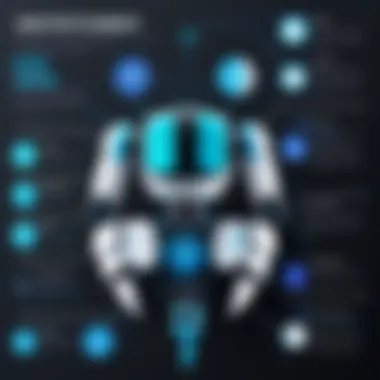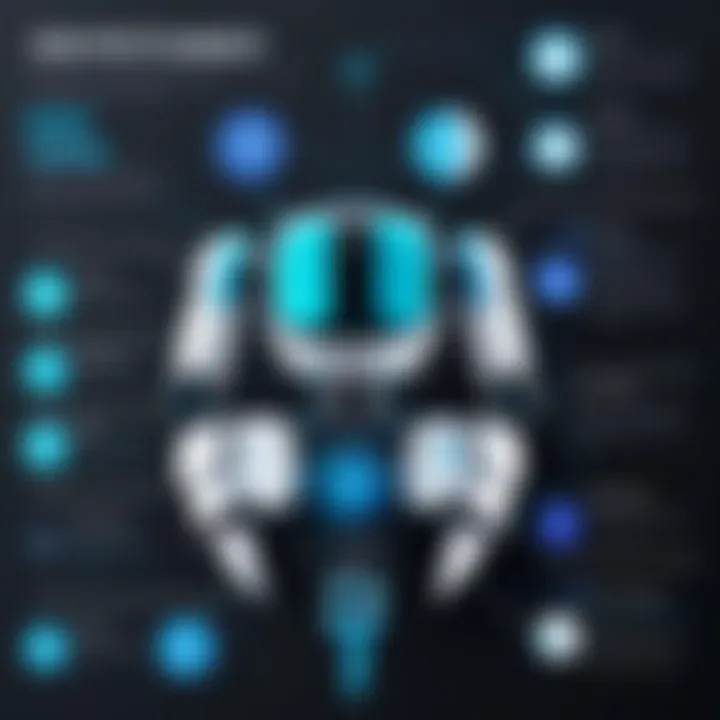Drift Chatbot Pricing Explained for Businesses


Intro
In today’s digital landscape, enhancing customer engagement through technology has become a cornerstone for businesses that want to stay ahead of the game. Drift’s chatbot solutions, designed to bridge the conversation gap between companies and their clients, play a crucial role in this dynamic environment. As IT decision-makers, entrepreneurs, and industry advisors explore options available to them, understanding the pricing structure of these chatbots is of utmost importance.
Navigating the world of chatbot technology can feel a bit like stepping into a maze. There are different pricing models, each offering unique features and functionalities, tailored to varying needs. This article is crafted to provide a clear path through that maze. By dissecting Drift’s pricing alongside its functionalities, we can shed light on why businesses may opt for this tool over others. In short, understanding the nuances of Drift chatbot pricing can empower your decision-making process and ensure you're making a well-informed choice for your organization.
Software Overview
Brief Description of Software
Drift is a conversational marketing platform that specializes in automating customer interactions. Designed primarily for companies aiming to improve customer engagement, Drift focuses on real-time conversations. It integrates seamlessly into websites, acting as a virtual concierge that can answer questions, qualify leads, and even assist with sales processes. Rather than simply mimicking human conversation, Drift aims to enhance the customer experience by anticipating user needs and responding accordingly.
Key Features and Functionalities
This software comes loaded with features designed to foster engagement and efficiency. Some of the standout functionalities include:
- Live Chat Integration: The ability to switch from chatbot to human interaction seamlessly.
- Lead Qualification: Automatically scores leads based on the interaction, helping sales teams prioritize inquiries.
- Scheduling Meetings: Users can book meetings directly through the chatbot, simplifying the process for both clients and businesses.
- Analytics Dashboard: Monitor interactions, conversion rates, and customer behavior through an in-depth analytics interface.
Equipped with these features, Drift positions itself as more than just a chatbot; it’s a comprehensive solution for creating personalized customer experiences.
Detailed Comparison
Comparison with Competitors
When weighing your options, understanding how Drift stacks up against others in the market is essential. Products like Intercom, Zendesk, and Microsoft Bot Framework also vie for attention. Each of these tools has its unique strengths, but there are notable differences:
- Intercom: Known for its user-friendly interface and robust integration capabilities. However, it often comes with a steeper pricing curve.
- Zendesk: While it offers extensive support features, its chatbot functionalities may not be as advanced as Drift’s conversational capabilities.
- Microsoft Bot Framework: Highly customizable but may require more technical expertise to implement than most businesses are willing to invest.
Drift tends to challenge these competitors by emphasizing ease of use and the ability to generate meaningful interactions that directly contribute to sales outcomes.
Pricing Structure
Understanding how Drift prices its solutions is critical for making an informed choice. The pricing model can often feel overwhelming, yet it's crucial to realize that it aligns with the value provided. Drift typically offers a tiered pricing structure with various plans:
- Basic Plan: Designed for small businesses, this plan offers fundamental chatbot functionalities along with basic analytics features.
- Pro Plan: Aimed at growing teams, this includes advanced features such as better lead qualification and integrations with third-party applications.
- Enterprise Plan: Tailored for large organizations, this plan is more customized and includes features such as priority support and dedicated account management.
In essence, while Drift might not be the cheapest option available, its pricing reflects comprehensive capabilities that can ideally enhance customer engagement. Evaluating your business needs against the offerings of Drift will ensure you find not just an affordable solution, but one that delivers real value.
Overview of Drift Chatbots
Understanding Drift chatbots is key for any business considering leveraging automated conversational tools for better customer engagement. These chatbots are not merely software; they serve as a bridge between businesses and their customers, ushering in an era of efficiency and productivity. Companies today are bombarded with inquiries, and Drift chatbots have emerged as reliable support systems. Importantly, they streamline communication, ensuring customers receive timely responses while freeing up human resources for tasks that require a personal touch.
Purpose and Functionality
Drift chatbots are designed with specific purposes in mind that focus heavily on enhancing customer interactions. They automate mundane tasks and facilitate communication, acting as the first point of contact for inquiries. Their ability to engage visitors, answer questions, and even collect information allows businesses to operate at a higher capacity. This not only improves response times but also enriches data collection and analytics, ultimately empowering organizations to make informed decisions.
The functionality extends beyond simple question-answering. Drift chatbots leverage AI to learn from interactions, thereby enhancing their performance over time. For instance, they can recommend products based on user behavior or even push promotions that align with customers’ interests. Flexibility in deployment, whether on websites, apps, or social media, further elevates their utility. In short, they provide a multi-faceted tool that addresses various business needs while improving customer satisfaction.
Use Cases in Business Contexts
The versatility of Drift chatbots is notable, as they find applications across various industries. Here are some concrete examples:
- E-commerce: They assist customers with finding products, tracking orders, and resolving issues that might arise during the purchase process.
- Customer Service: By offering immediate answers to FAQs, they drastically reduce wait times and enhance customer experiences.
- Lead Generation: Companies use these chatbots to qualify leads by asking tailored questions, thus providing sales teams with valuable information.
- Appointment Scheduling: Drift chatbots can handle booking appointments, eliminating the back-and-forth often seen in scheduling.
In today’s competitive business landscape, organizations that adopt such technologies are more likely to thrive. The ability to scale customer support while maintaining high-quality interaction resonates well with both customers and decision-makers. Understanding Drift chatbots, therefore, sets the stage for appreciating more complex elements like their pricing structure, which is essential for budgeting and strategic planning.
Pricing Tiers of Drift Chatbot Solutions
Understanding the various pricing tiers for Drift's chatbot solutions is crucial for making informed decisions as an IT professional, entrepreneur, or advisor. Pricing impacts not only the initial selection of the chatbot but can also influence future integrations, scaling efforts, and overall return on investment. Therefore, a thorough grasp of what each tier offers empowers decision-makers to choose a plan that aligns not only with current business needs but also with future ambitions.
Free Tier Overview
The Free Tier of Drift serves as an ideal entry point for businesses looking to dip their toes into the world of chatbots without incurring any initial costs. This tier allows users to get a flavor of Drift's capabilities, mainly focused on basic functionalities.
Within this plan, users can:


- Access core chatbot features, which include ready-made responses and integration with common platforms like Facebook Messenger.
- Use fundamental analytics to track engagement and conversations happening through the chatbot.
- Leverage basic email follow-up capabilities to maintain communication with users.
However, while the Free Tier certainly lowers the barrier to entry, it is essential to understand its limitations. Businesses running a higher volume of interactions or requiring advanced functionalities may find this basic plan falls short. Still, for small startups or businesses experimenting with customer engagement, it can be a valuable stepping stone.
Essentials Package Features
As businesses begin to see the value in automated responses, many opt for the Essentials Package, which offers a more expansive feature set. This tier is designed to enhance user experience significantly and provides several additional functionalities that stand to increase engagement rates.
Key features of the Essentials Package include:
- Multiple chatbots customizable to specific business needs, allowing for varied conversational interfaces depending on the visitor's journey.
- Advanced segmenting of user interactions to tailor responses better and increase relevance.
- Integration capabilities with CRM systems such as Salesforce and HubSpot for seamless customer relationship management.
- Enhanced analytics that go beyond basic statistics, showcasing user behavior trends for more strategic decision-making.
This tier often becomes the sweet spot for many mid-sized businesses, as it combines value with advanced features, enabling improved customer interaction without breaking the bank.
Advanced Package Offerings
For enterprises seeking to capitalize on the advantages of Drift chatbots, the Advanced Package presents a wealth of features that can revolutionize customer interaction standards. This tier builds upon the Essentials, offering sophisticated tools and analytics to optimize performance.
Some differentiating features include:
- AI-driven response suggestions that utilize previous interactions to learn and adapt.
- Integration with advanced marketing automation tools to streamline lead generation and conversion processes.
- Detailed performance metrics, including live chat analytics and user engagement stats, to facilitate immediate improvements in strategy.
- A wider array of customization options, allowing for distinct branding elements in the chatbot interface.
It's evident that larger enterprises or those managing extensive customer interactions will find tremendous value in this tier, as it effectively supports comprehensive customer service initiatives.
Enterprise Solutions and Custom Pricing
For organizations that have specific needs that aren’t adequately met by the previous packages, Drift offers custom pricing solutions tailored to unique business requirements. This flexibility ensures that companies can have a chatbot system designed around their actual scenario rather than trying to fit into a predetermined plan.
Key considerations include:
- Scalability: Custom solutions allow businesses to scale their chatbot capabilities in sync with growth, deploying additional features as needed without worrying about outgrowing the initial contract.
- Dedicated Support: Companies at this level often benefit from priority support, ensuring that technical issues are addressed swiftly.
- Full Customization: The ability to fully customize functionalities according to specific industry needs—be it high-touch client engagement or hyper-targeted marketing initiatives—makes this option exceedingly appealing.
Engaging in a direct dialogue with Drift’s sales team can yield a highly tailored experience, ensuring that you’re truly leveraging the capabilities of your chatbot.
A well-structured pricing model not only informs initial engagement but also sets the stage for sustained customer interactions and business expansion.
Factors Affecting Drift Chatbot Pricing
Understanding the factors that influence Drift chatbot pricing can be the difference between a wise investment and a regrettable expenditure. With businesses increasingly turning to chatbots for customer engagement and support, there are numerous elements to consider that directly impact the cost of implementing Drift's solutions. This section will dissect these factors, offering insights into the nuances that shape the pricing structure. By grasping these elements, decision-makers, IT professionals, and entrepreneurs can better tailor their selections to suit their organizational goals.
Feature Set and Customization
The breadth of features and the level of customization available in Drift chatbots play a crucial role in determining the pricing. Various capabilities, such as advanced analytics, integration with CRM tools, and personalized dialogue flows, can elevate the chatbot experience but often come with higher costs.
Businesses should assess their unique needs against the features offered. For instance, if a company only requires basic functionalities—like answering FAQs or directing customers to relevant resources—most of the entry-level plans might suffice. However, for organizations aiming for an expanded chatbot role, a more sophisticated plan might be worth the investment. A careful evaluation of these features ensures that decision-makers don’t end up paying for the bells and whistles when they only need a simple solution.
Monthly vs. Annual Billing
Understanding the billing cycle also impacts the overall investment in Drift chatbots. Drift typically provides options for monthly or annual billing. Companies might opt to pay monthly for flexibility, especially if they're cautious about long-term commitments. Yet, this choice often leads to significantly higher costs over time. In contrast, annual plans tend to offer cost savings. A company considering a long-term deployment might find that locking in an annual fee makes fiscal sense.
Furthermore, it’s vital to weigh the commitment level against the expected growth and interaction levels. If an organization foresees expansion in customer interactions that necessitate a more robust chatbot setup, the savings from choosing an annual plan can be substantial.
User Volume and Interactions
Another essential factor affecting pricing is user volume and interaction levels. Drift chatbots generally charge based on the number of monthly active users or interactions. For companies with fluctuating user engagement, this can lead to unpredictable costs.
Higher user volumes can increase the overall expenses, especially for businesses experiencing a surge in customer inquiries. Therefore, projecting potential growth and examining current interactions become pivotal for budgeting.
"If you think scaling is just a breeze, you might want to take another look. Costs can balloon if you don't keep your eyes peeled."
Thus, businesses should have a clear understanding of their customer base and how it might shift over time. Knowing these factors beforehand enables smarter financial planning and helps avoid surprises down the road.
Comparative Analysis with Competitors
In a competitive landscape, understanding how Drift's chatbot pricing stacks up against its rivals is pivotal for informed decision-making. This analysis serves as a compass for businesses navigating the myriad options available in the chatbot realm. With so many players vying for attention, grasping how features, customer support, pricing strategies, and market positioning differ from one another informs not just which tool to choose but also how to integrate it into one's broader business strategy.


Drift vs. Intercom
When pitting Drift against Intercom, several key aspects warrant consideration. First off, Intercom is known for its robust integration capabilities, appealing to businesses seeking to enhance their customer communication pipelines. While both platforms offer live chat, Drift leans heavily towards automation through AI functionality, making it a preferable choice for businesses that prioritize efficiency over personal touch.
- Pricing Structure: Drift offers clearer tiered pricing which includes a free tier, comfortable for startups and smaller businesses. Intercom, on the other hand, generally tends to lean towards a more premium pricing model which can add up, especially due to add-ons and features.
- User Experience: Users often find Drift’s interface to be more intuitive, especially those new to chatbots. Intercom, while powerful, may require a learning curve that could alienate certain users.
- Feature Comparison: If automation and triggered messaging are a priority, Drift often takes the crown. Meanwhile, Intercom’s strength lies in its help desk features and customer engagement analytics, which some businesses may find indispensable.
In summary, both platforms offer distinct value propositions but differ mainly in terms of user experience and pricing transparency.
Drift vs. Zendesk
Zendesk is another significant competitor in the chatbot and customer service arena. Renowned for its customer service solutions, Zendesk has made strides in chatbot capabilities, but there are notable highlights when comparing it to Drift.
- Integration with CRM: Zendesk's deep integration with their own CRM system can be a double-edged sword; while it strengthens overall service for existing Zendesk users, it can pose challenges for those using different systems. Drift, meanwhile, provides a broader range of integration options, making it a flexible choice for businesses that utilize various technologies.
- Customizability: Drift allows for considerable customization in its bot setups, which can be beneficial for businesses with unique customer journeys. Zendesk, however, offers less flexibility in bot configuration, which may hinder those needing bespoke solutions tailored to their specific processes.
- Pricing Complexities: The pricing model at Zendesk can often be seen as convoluted, with additional costs for necessary integrations. Drift’s pricing is more straightforward which could be a deciding factor for businesses with tighter budgets.
Ultimately, both platforms fulfill different needs, and the choice will largely depend on specific business priorities, be it customer service depth or adaptable chatbot solutions.
Market Position Relative to Alternatives
Drift is increasingly positioning itself as a major player in the chatbot industry, yet it's essential to analyze this position among broader alternatives, such as Freshchat or Chatbot.com.
- Trends in Customer Service: There's a marked trend towards automation in customer service interactions, and Drift’s focus on conversational marketing places it at the forefront of this shift. With tools geared toward qualifying leads and engaging visitors proactively, Drift shows a strong commitment to benefiting the sales funnel.
- Niche Focus vs. General Use: Drift tends to cater primarily to sales and marketing departments, offering tools that assist more with lead generation rather than general usage across departments. Conversely, alternatives like Freshchat target a more diverse audience, including support teams.
- Value for Money: Drift’s value proposition can often seem more pronounced for those primarily interested in AI-driven engagement. However, for overall customer service platform needs, businesses might find alternative solutions more comprehensive but at a higher cost.
Drift's focused approach on automation and conversation optimization makes it a standout choice for businesses eager to maximize lead conversion through smart technology.
Value Proposition of Drift Chatbots
The value proposition of Drift chatbots is quite crucial, particularly for the informed minds at the helm of business decisions. When exploring how Drift’s solutions measure up, it’s about more than just the initial costs or features. Effective utilization of Drift chatbots can often lead to significant boosts in operational efficiency and customer satisfaction, which can far outweigh the typical outlay.
Drift’s chatbots serve as more than just digital assistants—they are integrated tools that enhance user experience and streamline communication. This enhanced interaction can lead to quicker problem resolution and improved customer engagement, ultimately translating into tangible benefits. Having the ability to effectively communicate with potential clients in real-time provides companies a competitive edge not always found with traditional customer service methods.
ROI Considerations
When pondering the return on investment (ROI) afforded by Drift chatbots, businesses must consider multiple dimensions. One notable aspect is the way Drift solutions can alleviate tasks from human agents, allowing them to focus on more complicated issues or high-value relationships. This delegation can not only save time but also reduce staffing costs over time.
It’s not just about savings, though. The potential for increased sales should also be in focus. Chatbots can guide users through your digital displays, recommend products, and ultimately convert queries into purchases. With automated marketing follow-ups, you may capture leads that would otherwise slip through the cracks. Here are some key ROI aspects worth evaluating:
- Cost Savings: Less need for customer service personnel after implementing bots.
- Time Efficiency: Quicker response times can lead to higher customer retention.
- Sales Conversion: Enhanced ability to convert visitors into customers, boosted by relevant replies and suggestions.
"In the end, tools like Drift chatbots can transform mundane transactions into meaningful interactions, allowing for individualized customer experiences that are hard to replicate."
Customer Engagement Metrics
Understanding customer engagement metrics is essential for any business exploring Drift chatbots. Metrics offer insights into how users are interfacing with the chatbot solutions. Key indicators can include:
- Interaction Rates: How often users engage with the bot compared to overall traffic.
- Session Duration: The amount of time visitors spend conversing with the chatbot, which can hint at the quality of interaction.
- Conversion Rates: The percentage of interactions that lead to a desired action, such as signing up for a newsletter or completing a purchase.
These metrics not only reveal how effectively the bot is functioning, but they also guide decisions for future enhancements. Drifting away from generic responses to personalized engagement can position a business at the forefront of customer experience. By paying attention to these indicators, IT professionals and decision-makers can refine strategies, ensuring that Drift chatbots consistently deliver value and adapt to shifting consumer expectations.
In summary, the value proposition that Drift chatbots offer is multi-faceted—with a focus on ROI and customer engagement metrics, businesses can assess their current performance accurately and refine their strategies accordingly. This is not merely about utilizing tech; it's about cultivating a deeper connection with customers in an increasingly automated world.
Best Practices for Selecting Drift Chatbot Pricing
Selecting the right pricing model for Drift chatbots is more than just a numbers game. It’s about making a strategic decision that aligns with your business goals, customer engagement strategies, and operational needs. Understanding the intricacies of pricing tiers, discounts, and additional costs can turn what might seem like a daunting task into a streamlined process. Here, we lay out best practices that will help decision-makers in evaluating options effectively.
Assessing Business Needs
Before diving into the specific packages that Drift offers, it’s crucial to take a step back and assess your business needs.
- Identify Core Objectives: What are you hoping to achieve with a chatbot? Are you looking to boost lead generation, improve customer service, or streamline operations? Having a clear vision will help guide your selection process.
- Evaluate Current Infrastructure: Consider how well a chatbot would integrate into your existing systems. Are there specific platforms you already use that you want the chatbot to work with?
- Understand Customer Behavior: Analyze how your customers interact. If they often seek assistance after hours, a chatbot could be a game changer. This lays a strong foundation for narrowing down the features that matter most.
Taking the time to clearly assess these needs can lead to better choices, ensuring that you aren’t underwhelmed or overwhelmed by features you don’t need.
Aligning Features with Objectives
Once you’ve grasped your business needs, the next step is aligning those needs with the features offered in various Drift pricing tiers.


- Review Feature Sets Carefully: Different packages offer varying levels of functionality. Make sure to map out your requirements against the features provided. If a particular feature can dramatically enhance engagement, consider investing more.
- Customize Where Possible: Drift allows for some customization. If certain standard features don’t fit well with your operations, investigate whether custom features could be included in your package.
- Think Long-Term: Consider future needs. Your business will evolve, and so should your chatbot capabilities. Opt for a plan that allows for scaling and additional features down the line, preventing costly migrations later.
Choosing the right pricing plan involves not just a financial decision. It’s about strategic alignment with your business ethos.
In summation, selecting the right Drift chatbot pricing should be a well-thought-out process. Assessing business needs and aligning those with the specific features available creates a robust framework for making a decision that will serve your business well into the future.
Customer Support and Additional Costs
Understanding the nuances of customer support and additional costs related to Drift chatbot pricing is essential for businesses that want to maximize their return on investment. Pricing for chatbots often goes beyond the basic monthly fees or one-time payments. Hidden costs might catch companies off-guard if they don’t scrutinize their plans carefully.
Understanding Support Structures
In the landscape of Drift's customer support offerings, it’s imperative to grasp the different tiers of assistance available. Simple inquiries might be addressed through AI, but when it comes to more complicated issues, having robust human support is crucial. Drift provides several channels for support including email, live chat, and even a comprehensive knowledge base. This allows users to pick the method that best suits their urgency and preference.
The level of support you choose often reflects on how you plan to deploy the chatbot. For instance, startups or smaller firms might only need basic support, relying heavily on the wealth of resources available online. Conversely, larger enterprises might require dedicated account managers or priority support to ensure smooth day-to-day operations. By aligning support needs with business expectations, decision-makers can avoid potential pitfalls of underestimating support requirements.
"A well-supported chatbot isn��’t just nice to have; it's a lifeline when things go awry."
Training and Onboarding Expenses
Equipping your team to utilize Drift's chatbot effectively can incur additional training costs. While Drift provides intuitive interfaces, the effectiveness of the chatbot often hinges on how well your staff understands its functionalities and capabilities. This means either investing time to self-learn through webinars and resources or dedicating budget to engage professional trainers.
Also, depending on the size of the team, onboarding could become a hefty expense. It's not uncommon for organizations to overlook the effort it takes for team members to become well-versed in managing chatbots. Lack of training can lead to miscommunication, missed opportunities for engagement, and eventual underutilization of the tool.
Additionally, if an organization chooses to customize the chatbot to integrate it better with existing systems, expect to invest further in a consultant or developer. Balancing the long-term benefits of training against the immediate costs is key. Successful onboarding could significantly increase the efficiency of the chatbot, lessen reliance on customer support, and ultimately lead to better customer satisfaction.
Long-term Considerations
Understanding long-term considerations in Drift chatbot pricing is crucial for businesses looking to integrate these conversational tools into their operations. As companies expand, their needs evolve, which makes it essential to choose a pricing plan that is not only suitable for today but also adaptable over time. Businesses often focus on immediate costs and forget about the impact of scalability and adaptability on their bottom lines.
Choosing the right Drift chatbot pricing plan involves analyzing and anticipating future growth. A plan that meets the current requirements might not be flexible enough to support significant scaling, leading to potential interruptions in service or, in worse cases, requiring a complete overhaul. Businesses should weigh the benefits of flexible contracts that allow for growth, as opposed to rigid plans that might trap them into obsolescence sooner than expected.
Another point to consider is the technological landscape's rapid shifts. Companies must ensure that the Drift chatbot they choose will continue to serve them as advances occur. It may also involve evaluating the company's commitment to ongoing updates and improvements to keep pace with industry standards.
Scalability of Pricing Plans
With the fast-paced nature of business today, scalability is often at the forefront of decision-making for IT professionals. Drift’s pricing plans are built with this in mind, allowing businesses to adjust their subscriptions according to user volume and interaction needs. Companies may start with a smaller team utilizing the chatbot and as engagement grows or more functionalities become vital, they can shift to a more expansive plan.
- Flexible Tiers: Drift offers various tiers that accommodate a range of business sizes—from startups to enterprises. By allowing businesses to scale up as they grow, Drift helps to mitigate the risk of becoming locked into a plan that no longer serves their needs.
- Resource Allocation: Larger organizations can optimize their resource allocation by selecting scalable options, ensuring that they are not overpaying for features they don't use while still being equipped to expand when necessary.
This careful balancing act allows a smooth transition with minimal disruption to operations.
Adaptability to Evolving Business Needs
Business needs are not static; they evolve as market demands shift and customer expectations change. Thus, adaptability within any Drift chatbot pricing plan is vital. Customers should be reassured that their chosen plan can shift in tandem with their business strategies.
- Feature Adjustment: As the needs for customer engagement tools change, having a pricing model that allows for adjustments in features means companies can stay ahead of the curve without incurring exorbitant costs. If a business finds itself needing more complex integrations or additional support, adaptability in the pricing plan becomes invaluable.
- Market Responsiveness: Quick access to new features or changing existing ones leads to improved responsiveness to market conditions. With Drift’s model, businesses can pivot strategies on the fly, making changes as needed without needing to overhaul their entire systems.
Ultimately, understanding the long-term implications of Drift chatbot pricing can empower professionals to make informed choices that contribute to both immediate efficiencies and future growth.
End on Drift Chatbot Pricing
In discussing Drift chatbot pricing, it’s essential to recognize how pivotal the topic is for businesses aiming to leverage this technology. The pricing structure is not merely a number; it directly reflects the capabilities a organization can unlock. Understanding the pricing model aids IT decision-makers in evaluating the most suitable pathway for integrating chatbots into their customer service framework. A well-chosen pricing tier can lead to substantial improvements in customer engagement, operational efficiency, and overall sales.
When looking at Drift, one must consider not only the financial implications but also how the chosen package aligns with current and future business needs. The flexibility in customization offers companies a chance to tailor solutions that fit their unique requirements. For example, a small start-up might opt for the essentials package, while a blossoming enterprise may find that advanced offerings are necessary to accommodate rising demand.
Importantly, this conclusion encapsulates the considerations surrounding Drift's value proposition. Here are key points to ponder:
- Feature Analysis: Assess how features provided in different tiers can serve your business strategically.
- Scalability: Evaluate if the pricing plans can grow with your company. You want costs to make sense as your use case evolves.
- Long-term Value: Reflect on whether the investment offers sustainable benefits beyond mere automation.
"Pricing isn't just a line item; it's an ongoing narrative that impacts how businesses thrive in a competitive landscape."
By thoughtfully considering these aspects, businesses can make informed choices that not only enhance their customer interaction but also fortify their bottom lines in a crowded marketplace.
Final Thoughts for Advisors
Advisors play a crucial role in guiding businesses toward profitability and efficiency. In the context of Drift chatbot pricing, decision-makers should consider the unique needs of the organization. This is a time for in-depth consultations. Clients often benefit from tailored strategies that address specific pain points while maximizing potential ROI. One of the pressing issues is the misconception that the highest tier equates to the best value. Advisors must encourage clients to assess their specific requirements, testing assumptions against available features in each package.
Recommendations for Implementation
- Conduct a Needs Assessment: Start by gathering input from various stakeholders to identify gaps in current customer engagement practices. Are there issues with response times, or a lack of personalization?
- Pilot the Solutions: Before committing to higher-tier packages, pilot different Drift solutions. This addresses immediate questions about usability and effectiveness.
- Focus on Training: Implementation is as much about people as it is about technology. Invest in training for staff to ensure they leverage the chatbot fully
- Monitor Effectiveness: Post-implementation, keep an eye on metrics related to customer satisfaction and engagement. Tweak as necessary to optimize results.
- Be Open to Evolution: Business needs change, and so should your chatbot strategy. Regularly review performance and adjust your approach to Drift’s offerings.
Overall, a sensible approach toward Drift chatbot pricing can pave the way for enhanced customer interactions and long-term business growth.







